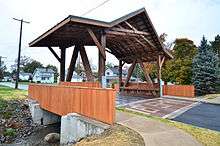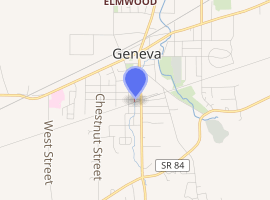West Liberty Covered Bridge
The West Liberty Covered Bridge is a covered bridge which carries West Liberty Street across Cowles Creek in Geneva, Ohio, United States. At 18 feet (5.5 m), it has been called the shortest covered bridge in the United States.[2] The bridge, one of 17 drivable covered bridges in the county, was designed by John Smolen, former Ashtabula County Engineer and the designer of the Smolen–Gulf Bridge, the longest covered bridge in the U.S., also in Ashtabula County.
West Liberty Covered Bridge | |
|---|---|
 | |
| Coordinates | 41.79915°N 80.9485°W |
| Crosses | Cowles Creek[1] |
| Locale | Geneva, Ohio |
| Maintained by | City of Geneva, Ohio |
| Characteristics | |
| Total length | 18 feet (5.5 m)[2] |
| No. of spans | 1 |
| History | |
| Designer | John Smolen[2] |
| Construction start | 2010 |
| Construction end | 2011 |
| Opened | 2011 |

| |
Construction
Conceived in 2007,[3] the bridge project proceeded in 2008 when the Ohio Public Works Commission supplied a grant for its construction.[1] The crossing used to be over a concrete culvert. When the culvert needed repairs, it was decided to replace it with a covered bridge, because it would be cheaper (or at least comparable, at $400,000) and also would add to the tourism created by Ashtabula County's other covered bridges.[1][4]
The foundation for the bridge was laid in September 2010,[5] with the bridge proper assembled starting the following month.[6] About 60 students from the Ashtabula County Joint Vocational School (now Ashtabula County Technical and Career Campus, or A-Tech) in nearby Jefferson Township contributed their labor, further defraying the costs.[6][4]
The bridge opened to traffic on August 22, 2011.[7] It was dedicated on October 8, 2011.[8] It has footpaths on both sides that are protected from road traffic.
Gallery

See also
- List of Ashtabula County covered bridges
References
- Trax Page, Margie (2008-08-14). "OPWC pays toll for shortest covered bridge". Star Beacon. Retrieved 2010-10-18.
- Mason, Everdeen (2010-09-29). "Nation's shortest covered bridge to be built in Geneva, Ohio". The Plain Dealer. Retrieved 2010-10-18.
- Trax Page, Margie (2007-10-08). "Geneva unveils big project: One short covered bridge". Star Beacon. Retrieved 2010-10-24.
- "Nation's shortest covered bridge to be built in Geneva, Ohio". cleveland.com.
- Feather, Carl E. (2010-09-04). "Smallest in the U.S. Growing Fast". Star Beacon. Retrieved 2010-10-18.
- Trax Page, Margie (2010-10-07). "Learning on the Job". Star Beacon. Retrieved 2010-10-18.
- Trax, Margie (2011-08-23). "Big Day for Little Bridge". Star Beacon. Retrieved 2011-08-30.
- Dillaway, Warren (2011-10-09). "Ashtabula County Has It Covered!". Star Beacon. Retrieved 2011-10-09.
.jpg)

.jpg)
